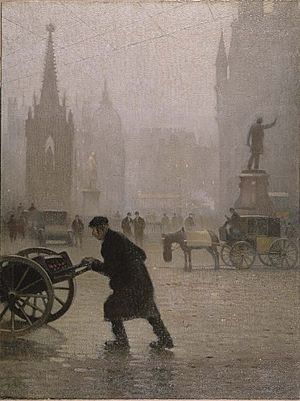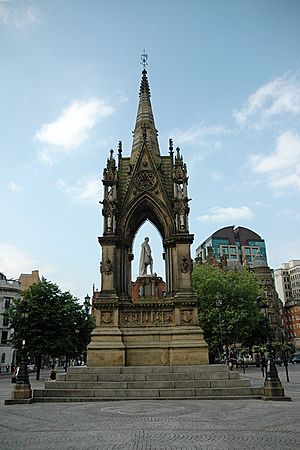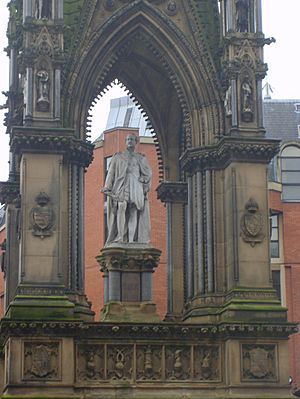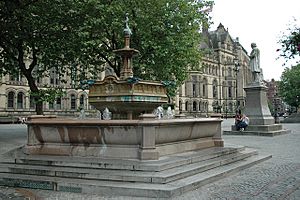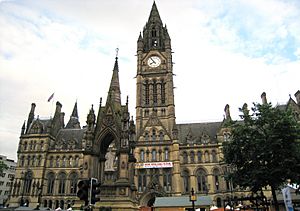Albert Square, Manchester facts for kids
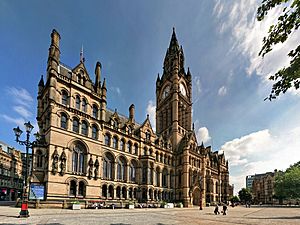
Albert Square, overlooked by Manchester Town Hall
|
|
| Maintained by | City of Manchester |
|---|---|
| Location | Manchester, England, UK |
| Coordinates | 53°28′46″N 2°14′42″W / 53.47944°N 2.24500°W |
| Construction | |
| Completion | c. 1864 |
Albert Square is a famous public square right in the middle of Manchester, England. The biggest building there is the amazing Manchester Town Hall. It's a Victorian Gothic building designed by Alfred Waterhouse. Many other older buildings from the same time surround the square.
The square has many statues and monuments. The largest one is the Albert Memorial. It honors Prince Albert, who was the husband of Queen Victoria. The square was named after Prince Albert. It was created between 1863 and 1867 to make space for his memorial. Work on the Town Hall started in 1868 and finished in 1877.
Contents
History of Albert Square
The area where Albert Square now stands was once empty land. It also had many houses close together. A small river called the River Tib used to flow nearby.
The idea for the square came from a plan to build a memorial for Prince Albert. He had passed away in 1861. At first, people thought about a library or a museum. But then they decided on a statue under a fancy canopy. They first wanted to put it in Piccadilly. However, its detailed Gothic style didn't match the buildings there. So, in 1863, the city offered land to create a new public space.
Many people supported the project. The Manchester Bricklayers' Protection Society even gave 50,000 bricks. They wanted to show their support for Queen Victoria. There were some building problems at first. The site had many old drains. All the donated bricks were used just for the foundations! So, in 1865, people started raising money. They collected over £6,000, even during tough times like the Cotton Famine.
Clearing the land began in 1864. More than 100 buildings were torn down. This included a pub, a coffee factory, and warehouses. The project got a boost when the Prince and Princess of Wales visited in 1869. They came to open the Albert Monument.
It was also decided that Manchester needed a new town hall. The old one was too small. A competition was held, and Alfred Waterhouse's Gothic designs were chosen. The new Town Hall began in 1868 and was completed in 1877.
In 1972, the area around Albert Square became a special conservation area. This means its historic look is protected. Later, Lincoln Square was added to this area.
The center of Albert Square used to be a traffic circle. There were also bus stops on the west side. In 1987, the square was redesigned. The eastern side, in front of the Town Hall, became a pedestrian-only area. New stone paving and old-style street lights were added.
Monuments and Statues
The Albert Memorial
The biggest monument in Albert Square is the Albert Memorial. It is a very important historic structure. It honors Prince Albert. The memorial has a marble statue of Albert. He stands on a base and faces west. Matthew Noble designed the statue between 1862 and 1867. The statue is inside a large, Medieval-style canopy. This canopy was designed by architect Thomas Worthington. Queen Victoria herself approved the designs.
Worthington's design for the memorial was inspired by a church in Italy. It also might have been influenced by the Scott Monument in Edinburgh. That monument was built 20 years earlier.
The memorial has a fancy spire at the top. On each side, there are decorated gables. Inside the canopies are figures representing important ideas. These include art, business, science, and farming. Below these are smaller figures. They show specific parts of these ideas:
- The Four Arts: painting, architecture, music, sculpture
- Business: the Four Continents
- The Four Sciences: chemistry, astronomy, mechanics, mathematics
- Farming: the Four Seasons
The colored paving around the memorial was laid in 1987. It shows flowers that represent the four Home Nations: England, Ireland, Scotland, and Wales.
Over the years, there were ideas to move or even tear down the Albert Memorial. After the First World War, some wanted to replace it with a war memorial. This idea was stopped. When the memorial fell into disrepair, some thought it should be demolished. But people fought to save it many times. It was finally restored in 1976–77. A group raised £50,000 to fix it. This is noted on a plaque at its base.
Albert Memorial in London
Manchester's Albert Memorial was finished in 1865. It was one of the first Albert Memorials in the United Kingdom. It looks quite similar to the Albert Memorial in Kensington Gardens, London. The London memorial was completed about seven years later. Some people think Manchester's design influenced the London one. However, the London architect, George Gilbert Scott, said his idea for a medieval canopy was original.
Other Statues in the Square
Albert Square also has several other statues:
- Bishop James Fraser (1887)
- John Bright (1891)
- Oliver Heywood (1894)
- William Ewart Gladstone (1901)
- A fountain (designed by Thomas Worthington) was built for Queen Victoria's Diamond Jubilee in 1897. It was put back in the square in 1997 after being stored away for a while.
Gallery of Statues
-
Statue of John Bright
-
Statue of William Ewart Gladstone
Lincoln Square's Monuments
Next to Albert Square is Lincoln Square, created in 1981. It features:
- A fountain that celebrated the wedding of Prince Charles and Lady Diana Spencer in 1981. It is now a flower bed.
- A statue of Abraham Lincoln (1809–1865). He was the 16th President of the United States. This statue was given to Manchester in 1919. It honored Lancashire's role during the cotton famine and American Civil War. The Lincoln statue was moved to this square in 1986.
Important Buildings Around the Square
Albert Square is surrounded by many beautiful Victorian buildings. The largest and most famous is the Manchester Town Hall. Only the west side of the square has newer buildings. These are modern office blocks built in the 1980s.
Some notable buildings around Albert Square include:
- Manchester Town Hall (1868–77) – This is a grand building made of sandstone. It has a tall bell tower, about 280 feet (85 meters) high. The tower holds 23 bells. Alfred Waterhouse designed it. Inside, you can see large paintings by Ford Madox Brown.
- The Abbey National building (around 1900) – This is a bank building made of Portland stone. It has a curved front.
- Albert Chambers (1873) – These offices are made of sandstone. They were designed in a Venetian style.
- Carlton House (1872) – Also known as Bridgewater Buildings. These are offices made of sandstone in a Venetian Gothic style.
- St Andrew's Chambers (1874) – This is a Neo-Gothic sandstone building on a corner. It was designed for an insurance company.
- The Memorial Hall (1866) – This building was designed by Thomas Worthington for the Unitarian Church. It is located on the Southmill Street corner.
See Also
- List of public art in Greater Manchester
- List of Grade I listed buildings in Greater Manchester


